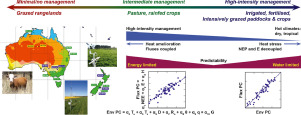当前位置:
X-MOL 学术
›
Agric. For. Meteorol.
›
论文详情
Our official English website, www.x-mol.net, welcomes your
feedback! (Note: you will need to create a separate account there.)
Carbon, water and energy fluxes in agricultural systems of Australia and New Zealand
Agricultural and Forest Meteorology ( IF 5.6 ) Pub Date : 2020-06-01 , DOI: 10.1016/j.agrformet.2020.107934 James Cleverly , Camilla Vote , Peter Isaac , Cacilia Ewenz , Mahrita Harahap , Jason Beringer , David I. Campbell , Edoardo Daly , Derek Eamus , Liang He , John Hunt , Peter Grace , Lindsay B. Hutley , Johannes Laubach , Malcolm McCaskill , David Rowlings , Susanna Rutledge Jonker , Louis A. Schipper , Ivan Schroder , Bertrand Teodosio , Qiang Yu , Phil R. Ward , Jeffrey P. Walker , John A. Webb , Samantha P.P. Grover
Agricultural and Forest Meteorology ( IF 5.6 ) Pub Date : 2020-06-01 , DOI: 10.1016/j.agrformet.2020.107934 James Cleverly , Camilla Vote , Peter Isaac , Cacilia Ewenz , Mahrita Harahap , Jason Beringer , David I. Campbell , Edoardo Daly , Derek Eamus , Liang He , John Hunt , Peter Grace , Lindsay B. Hutley , Johannes Laubach , Malcolm McCaskill , David Rowlings , Susanna Rutledge Jonker , Louis A. Schipper , Ivan Schroder , Bertrand Teodosio , Qiang Yu , Phil R. Ward , Jeffrey P. Walker , John A. Webb , Samantha P.P. Grover

|
A comprehensive understanding of the effects of agricultural management on climate–crop interactions has yet to emerge. Using a novel wavelet–statistics conjunction approach, we analysed the synchronisation amongst fluxes (net ecosystem exchange NEE, evapotranspiration and sensible heat flux) and seven environmental factors (e.g., air temperature, soil water content) on 19 farm sites across Australia and New Zealand. Irrigation and fertilisation practices improved positive coupling between net ecosystem productivity (NEP = −NEE) and evapotranspiration, as hypothesised. Highly intense management tended to protect against heat stress, especially for irrigated crops in dry climates. By contrast, stress avoidance in the vegetation of tropical and hot desert climates was identified by reverse coupling between NEP and sensible heat flux (i.e., increases in NEP were synchronised with decreases in sensible heat flux). Some environmental factors were found to be under management control, whereas others were fixed as constraints at a given location. Irrigated crops in dry climates (e.g., maize, almonds) showed high predictability of fluxes given only knowledge of fluctuations in climate (R2 > 0.78), and fluxes were nearly as predictable across strongly energy- or water-limited environments (0.60 < R2 < 0.89). However, wavelet regression of environmental conditions on fluxes showed much smaller predictability in response to precipitation pulses (0.15 < R2 < 0.55), where mowing or grazing affected crop phenology (0.28 < R2 < 0.59), and where water and energy limitations were balanced (0.7 < net radiation ∕ precipitation < 1.3; 0.27 < R2 < 0.36). By incorporating a temporal component to regression, wavelet–statistics conjunction provides an important step forward for understanding direct ecosystem responses to environmental change, for modelling that understanding, and for quantifying nonstationary, nonlinear processes such as precipitation pulses, which have previously defied quantitative analysis.
中文翻译:

澳大利亚和新西兰农业系统中的碳、水和能量通量
尚未全面了解农业管理对气候-作物相互作用的影响。我们使用一种新颖的小波统计联合方法,分析了澳大利亚和新西兰 19 个农场的通量(净生态系统交换 NEE、蒸发蒸腾和显热通量)和七种环境因素(例如气温、土壤含水量)之间的同步. 正如假设的那样,灌溉和施肥实践改善了净生态系统生产力(NEP = -NEE)和蒸发量之间的正耦合。高度密集的管理倾向于防止热应激,特别是对于干旱气候下的灌溉作物。相比之下,热带和炎热沙漠气候的植被中的应力回避是通过 NEP 和感热通量之间的反向耦合来确定的(即,NEP 的增加与显热通量的减少同步)。发现一些环境因素处于管理控制之下,而另一些则被固定为给定位置的约束。干旱气候下的灌溉作物(例如玉米、杏仁)在仅了解气候波动的情况下显示出高通量的可预测性(R2 > 0.78),并且在能源或水资源严重受限的环境中通量几乎同样可预测(0.60 < R2 < 0.89)。然而,环境条件对通量的小波回归显示对降水脉冲响应的可预测性要小得多(0.15 < R2 < 0.55),其中割草或放牧影响作物物候(0.28 < R2 < 0.59),并且水和能量限制是平衡的( 0.7 < 净辐射 ∕ 降水 < 1.3;0.27 < R2 < 0.36)。
更新日期:2020-06-01
中文翻译:

澳大利亚和新西兰农业系统中的碳、水和能量通量
尚未全面了解农业管理对气候-作物相互作用的影响。我们使用一种新颖的小波统计联合方法,分析了澳大利亚和新西兰 19 个农场的通量(净生态系统交换 NEE、蒸发蒸腾和显热通量)和七种环境因素(例如气温、土壤含水量)之间的同步. 正如假设的那样,灌溉和施肥实践改善了净生态系统生产力(NEP = -NEE)和蒸发量之间的正耦合。高度密集的管理倾向于防止热应激,特别是对于干旱气候下的灌溉作物。相比之下,热带和炎热沙漠气候的植被中的应力回避是通过 NEP 和感热通量之间的反向耦合来确定的(即,NEP 的增加与显热通量的减少同步)。发现一些环境因素处于管理控制之下,而另一些则被固定为给定位置的约束。干旱气候下的灌溉作物(例如玉米、杏仁)在仅了解气候波动的情况下显示出高通量的可预测性(R2 > 0.78),并且在能源或水资源严重受限的环境中通量几乎同样可预测(0.60 < R2 < 0.89)。然而,环境条件对通量的小波回归显示对降水脉冲响应的可预测性要小得多(0.15 < R2 < 0.55),其中割草或放牧影响作物物候(0.28 < R2 < 0.59),并且水和能量限制是平衡的( 0.7 < 净辐射 ∕ 降水 < 1.3;0.27 < R2 < 0.36)。











































 京公网安备 11010802027423号
京公网安备 11010802027423号